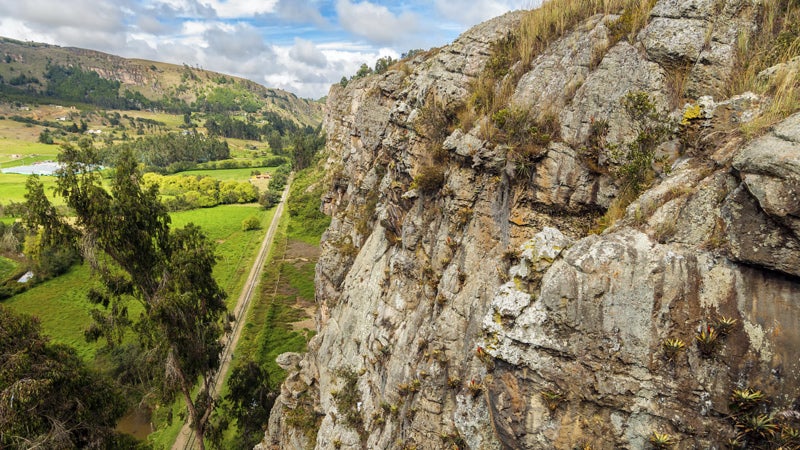I sit on a tiny ledge some 350 feet above abandoned railroad tracks running along a rock wall and try to reassure myself that I am not afraid of heights. After hiking up a wooded hillside and climbing the first two pitches, I can now see the green pastures and rolling hills that surround Suesca, a rural Colombian town about 50 miles northeast of Bogotá.
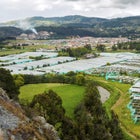 Greenhouses below the climbing wall.
Greenhouses below the climbing wall.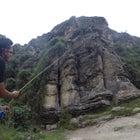
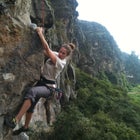
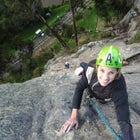
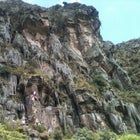
��
Off to my left stretch long rows of white greenhouses, where flowers are grown and exported to the U.S. Before me, the tree-lined Bogotá River snakes through the landscape. Off to my right, between the swaying eucalyptus trees, their leaves rustling in the late afternoon breeze, distant cliff faces turn orange as the sun sets.
Our Colombian guide, a Muisca Indian we call Carlitos, ties the anchor for the third pitch above me. He knows more than 300 routes like the back of his hand, and he’s selected one to match my skill level. I’ve climbed with Carlitos each of the dozen or so times I’ve come to Suesca. Each time, it’s like visiting with an old friend. Each time, too, we come across people he knows pretty much every 50 feet, which is convenient for sharing a top rope and for getting in a few extra climbs.
I scale the last 60 feet or so, past bromeliads blooming in the craggy rocks, and past hanging screens of Spanish moss, then make my way down to our camp in a cow pasture, trekking past mountain bikers and children flying kites.
Suesca is Colombia’s best hope for shedding its 1980s-era reputation as a hotbed of cocaine production and instead becoming an adventure sports destination. Some of Colombia’s national parks are in far-flung regions where guerrilla holdouts still roam and have been known to kidnap foreigners. The state of Cundinamarca, however, where Suesca sits in Colombia’s central Andes range, has been one of the country’s most secure regions for more than a decade. Here, Colombia’s premier rock-climbing site offers classic and sport routes that span beginner to 5.13c, not to mention mountain biking, kayaking, and spelunking. Any number of local outfitters can set you up the day you arrive with a quasi-English-speaking guide and gear—all for about 25 bucks for about four hours.
Suesca has the occasional problem of robbery in isolated areas on the weekends. For that reason, outfitter Andres Zamudio recommends always using a guide who knows their way around Suesca’s network of gravel roads and hilly pastures, some which are out of range of both cell towers and the town’s dozen police officers.
Despite the occasional crime, around 5,000 people (mostly Colombians) visit Suesca each month. They enjoy walking, picnicking, and horseback riding, and you can be sure the lower-level climbing routes will be crowded on weekends—all the more reason to hire a guide who knows the more secluded routes.
In 2013, about a dozen Suesca guides were certified by the Fernando Gonzalez Rubio Foundation, a nonprofit, which tested their knowledge of ropes, anchors, and climbing techniques. Graduates received climbing-guide ID cards.��
Nelson Mestizo, Suesca’s mayor, has worked closely with FGR to ensure safety in the area and to promote Suesca as a tourist destination. Mestizo hopes to one day make the area a national park—which would be OK with Zamudio, who’s been climbing there for more than 20 years. “You can stay for two weeks climbing and mountain biking,” he says, “and you’ll never get bored.”
If You Go
Read:
—a tourism page set up by some locals with fierce hometown pride—is a good place to start if you’re limited to English-only sites. Visit the city’s for restaurant, hostel, and outfitter information in Spanish.
How to time it:
Because Suesca, like much of Colombia, is just a few degrees north of the equator, temperatures are pretty steady year-round. The area sits at 8,500-feet and is breezy and sunny most of the year, with two rainy seasons. The drier months generally run from December to February, and from June to August. During the rainy seasons, you’re probably going to get good weather in the mornings and sudden showers in the afternoons, so climb early.
Bring:
A jacket, a rain poncho, bug spray, suntan lotion, and snacks. Vendors set up along the railroad tracks selling chips, soft drinks, and empanadas (fried cornmeal stuffed with ground beef or chicken and spices). If you’re lucky, an empanada lady might be trekking right by your climb site when you happen to be hungry.
Getting there:
Suesca is 40 miles northeast of Bogotá and four miles off Autopista Norte, a major highway. Suesca is also accessible from Bogotá’s TransMilenio northern terminal (catch an Alianza or Ayacucho bus).
Stay:
Pitch your tent next to some young Colombians for a lively local experience (cheap beer is available, which is useful for making friends). If you’d rather sleep on a mattress, there are several low-cost hotels and hostels within a ten-minute walk of the climbing wall.
Eat:
Suesca boasts plenty of small Colombian cafés that serve pizza and typical Colombian dishes for a few bucks. If you want a serious meal next to a warm fire, try , a stone’s throw from the wall. This restaurant-cum-hostel-cum outfitter, inspired by Indian, Nepalese, Chinese, and Thai cultures alike, was established by Luis Felipe Ossa, who in 2007 became the first Colombian to climb Everest without a supplemental oxygen tank.


